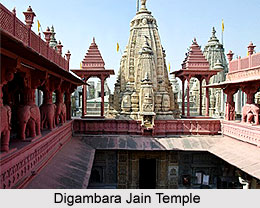 Digambara Jain Temple in Sanganer is situated 13-14 km south of the Jaipur City on National Highway No. 12, Kota on Jaipur Road. The temple is regarded as one of the historical places of Rajasthan. It is also referred as the jewel of town. Digambara Jain Temple is an Atishaya Kshetra. The principal deity of the temple is the first tirthankara, Lord Adinath or Bhagwan Rishabh Dev. The idol is believed to be almost 4000 years old and is made of local stone.
Digambara Jain Temple in Sanganer is situated 13-14 km south of the Jaipur City on National Highway No. 12, Kota on Jaipur Road. The temple is regarded as one of the historical places of Rajasthan. It is also referred as the jewel of town. Digambara Jain Temple is an Atishaya Kshetra. The principal deity of the temple is the first tirthankara, Lord Adinath or Bhagwan Rishabh Dev. The idol is believed to be almost 4000 years old and is made of local stone.
Architecture of Digambara Jain Temple
Digambara Jain Temple is rich in architectural beauty. This ancient temple has been decorated with fine delicate carvings and has been built in many phases. According to inscription of V.S. 1011 in one of the pylons (Toranas), the last phase of this spectacular temple was completed in 10th century A.D. the temple is adorned with sky-high `shikharas` or spires. The inner sanctum of this seven storied temple has a stone shrine with sky-high eight Shikharas (Pinnacles).
Digambara Jain Temple is made of red stone which are embellished with attractive images carved on it. An ancient small temple guarded by the Yaksha (Devas) is located in the underground portion.
It is said that only a Balyati (one celibate since childhood) ascetic digambara saint can only enter if he is equipped with his spiritual steadiness. He is only able to bring out the Idols of this underground temple for a limited period, which is declared and decided previously. The idols thus brought out for viewing of devotees, must be placed back with in auspicious signs.
As one enters the inner temple he comes across a beautiful nij-mandir (inner temple). It is a magnificent big stone built shrine with three pinnacles. The fine art that adorns the three pinnacles and the shrine serves as a feast to the eyes. In the centre of the inner temple there is an idol of Lord Parshwanatha with 7 serpent hoods. The idol is surrounded by carvings of lotuses, creepers and elephants pouring water from pitchers held in their trunks. The main idol is that of Lord Adinath that is installed in the shrine behind this. There are many other attractive idols installed in the temple.
The temple is visited by many devotees from different places. Every year during the second Sunday in the month of Ashwin the temple is flocked by thousands of devotees.




















